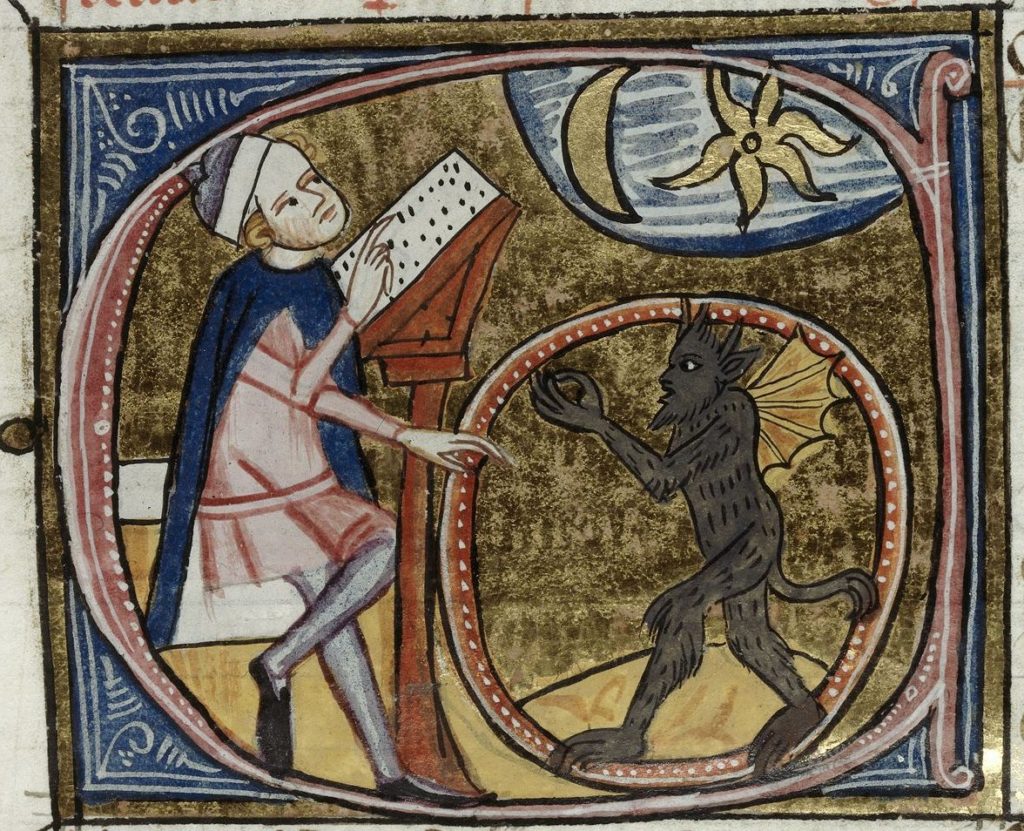This is the story of an inquisitor in the Middle Ages, buried treasure in early modern Germany, and the fine art of necromancy.
The concept of magic maps uneasily onto premodern Christian Europe, where recipes for curing illness could consist of wearing an amulet as readily as drinking an herbal potion, or a person might perform magic spells calling on angels, not forces of darkness. Medieval and modern scholars, however, agree that some particular acts were inherently magical. Chief among these ritual types was nigromancia: the conjuration and command of demons.

Dominican inquisitor Nicholas Eymerich of Aragon (c.1320-1399) had ample experience reading and condemning necromantic texts. [1] Thus, he had plenty of material to reference in his multiple books condemning necromancy. In Directorium inquisitorum, he laid out an example ritual that invoked demons to demonstrate how sorcerers show “honor or veneration or worship” [2] to demons by:
drawing a circle in the earth, by placing a boy in the circle, by fixing a mirror, a sword, an amphora, or other small body before the boy, and with the necromancer himself holding a book, and reading, and invoking the demon.[3]
The reference to a necromancer and his reading aloud suggest this spell comes from the “underworld” of learned magic, transmitted among the daring elite through texts in Latin, Hebrew, Arabic, and Greek. The rest of the ritual, however, seems to involve little beyond mechanical skill. Eymerich gives no information on the spell’s origin or purpose. His intent is to argue that necromantic rituals inherently involve venerating demons, even if there is no overt act of veneration.
Eymerich should have chosen a different example.

Nearly two centuries after Eymerich composed Directorium in 1376, a group of women went treasure-hunting in Augsburg. [4] As Regina Koch admitted to her interrogators, in May 1544 two women from Nuremberg had definitely not convinced her that there was a pot of money buried in her backyard, but she had allowed them to dig there anyway. One of the two women, along with at least two strange men, was outside during the digging.
Her interrogator’s unanswered questions to her, as reported by a scribe, suggest why they were so interested in these events:
10. Who called for this priest for this business, and where did he come from? 11. Did she not have burning wax or candles there? 12. Were these candles blessed, or were they just simple candles? And who provided them? 13. Did the priest and one of the women read out of a book in the hole, and make a cross, as well as say a blessing or a magic spell? 14. What was in the little pitcher that the woman had in the hole, and then gave back to the maid? [5]
The interrogator is clearly working from a base of earlier information. One of their other questions concerned which men had taken a bath with which women inside Koch’s house, so town gossip seems a likely source. Even so, the unanswered questions almost all involve activities that, taken alone, amount to standard Christian practice.
With the aid of other witnesses’ overlapping and conflicting testimony, however, a full story of the events in Koch’s backyard was constructed:
Sophia Voit and Otilia Wolkenstainer of Nuremberg brought a village priest, a young girl, and several men to Regina Koch Mauerin’s house, and Sophia Voit made a circle or ring, went around it with candles, then took a naked sword from a young man and marked a spot with it where they should dig. Afterward, she sat in the circle, stuck a cross or crucifix in the grass and lay a little cloth over it, and read out of a little book. The above-noted village priest also sat there and read from a little book, and both made crosses and magic signs. In sum, they were digging for treasure. [6]

This 1544 legal record recounts a previously unnoticed elaborate (and sometimes slightly confused) version of the spell Eymerich referenced in 1376. Furthermore, even if the clerk writing the summation had some familiarity with a text of learned magic and polished up witnesses’ testimony a bit, town gossip—street knowledge—played a major role in the compilation of events. The scribe was not merely substituting something he had once read in a book for the results of the interrogation.
The discovery of the near-mirror image of these two rituals across time, space, and environment raises questions about the transmission of magic that must remain frustratingly unanswered for now. It is worth, however, considering one last point from the legal record concerning Koch and the others:
In perpetrating this superstitious act, they seriously abused the name and word of God. [7]
The inquisitor had cared enough about this case to torture Koch for more information (she revealed nothing further!). But not a word was spoken about invoking or venerating demons—even in the full flame of witch hysteria. Nicholas Eymerich would not have been happy to hear about this conclusion—nor about Koch’s punishment of “a good talking to.”
In conclusion: Klaatu verata niktu, and happy All Hallows’ Eve! [8]
Cait Stevenson
PhD in History
University of Notre Dame
—
[1] Michael Bailey, “From Sorcery to Witchcraft: Clerical Conceptions of Magic in the Later Middle Ages,” Speculum 76, no. 4 (2001): 971. This article drew my attention to Eymerich and the sample spell recounted below.
[2] Nicholas Eymerich, Directorium inquisitorum R. P. F. Nicolai Eymerici… (Rome, 1578), 836.
[3] Translated in Bailey, 972.
[4] The records concerning Regina Koch and buried treasure are translated by B. Ann Tlusty in Tlusty, ed. and trans., Augsburg during the Reformation Era: An Anthology of Sources (Hackett Publishing: 2012), 242-46, which introduced me to this case.
[5] Trans. Tlusty, 243.
[6] Trans. Tlusty, 245.
[7] Trans. Tlusty, 245.
[8] Army of Darkness, directed by Sam Raimi (1990; Universal Pictures).
